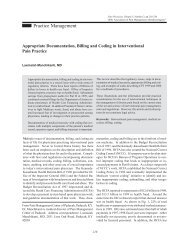ASIPP Practice Guidelines - Pain Physician
ASIPP Practice Guidelines - Pain Physician
ASIPP Practice Guidelines - Pain Physician
Create successful ePaper yourself
Turn your PDF publications into a flip-book with our unique Google optimized e-Paper software.
Manchikanti et al • <strong>ASIPP</strong> <strong>Practice</strong> <strong>Guidelines</strong><br />
36<br />
the local anesthetics and other agents used. Clear-cut explanations<br />
for these benefits are not currently available. It<br />
is believed that neural blockade alters or interrupts nociceptive<br />
input, reflex mechanisms of the afferent limb, self<br />
sustaining activity of the neuron pools and neuraxis, and<br />
the pattern of central neuronal activities (325). The explanations<br />
are based in part on the pharmacological and physical<br />
actions of local anesthetics, corticosteroids, and other<br />
agents. It is also believed that local anesthetics interrupt<br />
the pain-spasm cycle and reverberating nociceptor transmission,<br />
whereas corticosteroids reduce inflammation either<br />
by inhibiting the synthesis or release of a number of<br />
pro-inflammatory substances (326-332). Various modes<br />
of action of corticosteroids include membrane stabilization;<br />
inhibition of neural peptide synthesis or action; blockade<br />
of phospholipase A 2 activity; prolonged suppression<br />
of ongoing neuronal discharge; suppression of sensitization<br />
of dorsal horn neurons; and reversible local anesthetic<br />
effect (327-340). In addition, local anesthetics have been<br />
shown to produce prolonged dampening of c-fiber activity<br />
(341-343). Physical effects include clearing adhesions or<br />
inflammatory exudates from the vicinity of the nerve root<br />
sleeve. The scientific basis of some of these concepts, at<br />
least in part, is proven for spinal pain management with<br />
epidural injections of betamethasone, and intravenous<br />
methylprednisolone (330, 334-337).<br />
DIAGNOSTIC INTERVENTIONAL<br />
TECHNIQUES<br />
Diagnostic blockade of a structure with a nerve supply,<br />
which can generate pain, can be performed to test the hypothesis<br />
that the target structure is a source of the patient’s<br />
pain (32). Testing the hypothesis by provoking pain in<br />
any structure is an unreliable criterion except in provocative<br />
discography (175). However, neurodiagn-ostics of the<br />
involved nerve pathways has proven valuable. The relief<br />
of pain, however, is the essential criterion in almost all<br />
structures including analgesic discography in the cervical<br />
spine, the only deviation being lumbar discs (32). If the<br />
pain is not relieved, the source may be in another structural<br />
component of the spine similar to the one tested such<br />
as a different facet joint or a different nerve root or some<br />
other structure (32). Thus, precision diagnostic injections<br />
directed towards specific spinal pathology are potentially<br />
powerful tools for diagnosis of chronic spinal pain, but<br />
often technically challenging. Identifying the specific pathology<br />
responsible for pain is often difficult, leading to<br />
frustrated patients and clinicians. Nevertheless, these injections<br />
may be safely performed by properly trained anesthesiologists,<br />
physiatrists, neurologists, radiologists,<br />
spine surgeons and physicians from other related specialties<br />
who take the time to learn the basis for and perfect the<br />
application of these techniques.<br />
When the source of pain is more than one structure or<br />
multiple levels, it is not expected that all the pain will be<br />
relieved. For example, there may be painful facet joints<br />
bilaterally at a given segmental level, in which case anesthetizing<br />
the left joint should relieve the left side, but not<br />
the right side; there may be pain from two consecutive joints<br />
on one side, in which case anesthetizing the lower joint<br />
alone may relieve only the lower half of the pain; there<br />
may be more than one structure involved, such as pain<br />
contributed by discs and facet joints or facet joints and<br />
nerves (32).<br />
True positive responses are secured by performing controlled<br />
blocks. Ideally, this should be in the form of placebo<br />
injections of normal saline; but logistical and/or ethical<br />
considerations prohibit the use of normal saline in conventional<br />
practice.<br />
Rationale<br />
The rationale for diagnostic neural blockade in the management<br />
of spinal pain stems from the fact that clinical<br />
features and imaging or neurophysiologic studies do not<br />
permit the accurate diagnosis of the causation of spinal<br />
pain in the majority of patients in the absence of disc herniation<br />
and neurological deficit (28-30, 32, 33, 41, 42, 56,<br />
58, 62, 151-153, 162-164, 174-185, 306, 344-357). It was<br />
also shown that sacroiliac joint pain is resistant to identification<br />
by the historical and physical examination data (166,<br />
167, 191, 192, 358-360), even though some have claimed<br />
sensitivity in the range of 60% to 87% with multiple provocative<br />
maneuvers (361, 362). In addition, no corroborative<br />
radiologic findings have been identified in patients<br />
with sacroiliac joint syndrome (363-371). Further rationale<br />
is based on the recurring facts showing the overall<br />
rate of inaccurate or incomplete diagnosis in patients referred<br />
to pain treatment centers to range from 40% to 67%,<br />
the incidence of psychogenic pain to be only 1 in 3,000<br />
patients, and the presence of organic origin of the pain is<br />
mistakenly branded as psychosomatic in 98% of the cases<br />
(144, 145). Finally, the most compelling reason is that<br />
chronic low back pain is a diagnostic dilemma in 85% of<br />
patients even in experienced hands with all the available<br />
technology (Table 5). It has been determined that utilizing<br />
alternative means of diagnosis including precision diagnostic<br />
blocks in cases where there is a lack of definitive<br />
diagnostic radiologic or electrophysiologic criteria can<br />
<strong>Pain</strong> <strong>Physician</strong> Vol. 4, No. 1, 2001
















